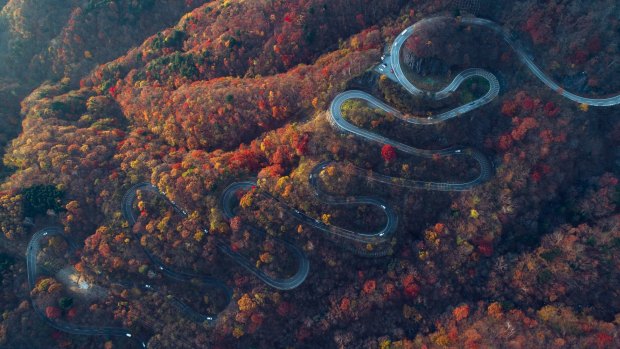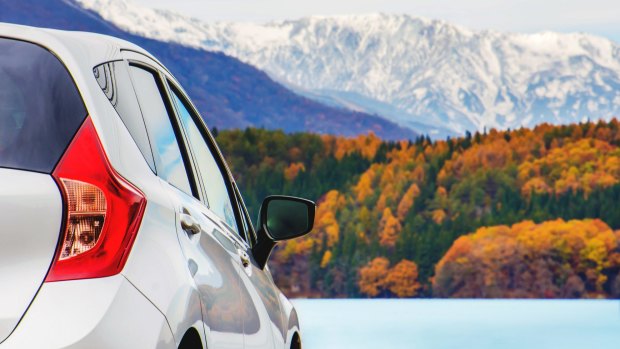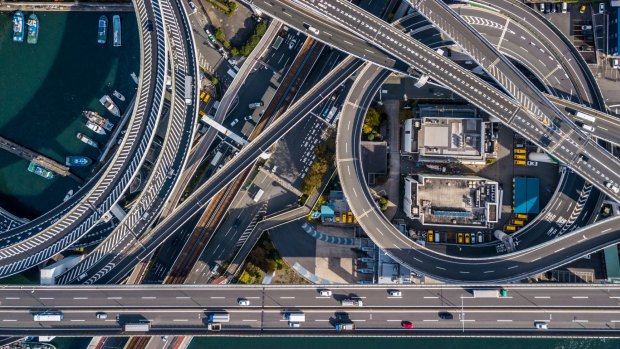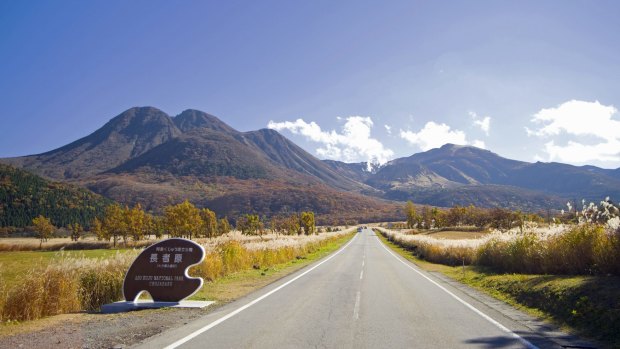Driving in Japan: Self-drive road trip through Aso-Kuju National Park
By Brian Johnston

Warning: Curves ahead. Nikko Mountain, Japan.Credit: SHUTTERSTOCK
The paperwork is done surprisingly quickly, and soon an attendant in a natty uniform and perky cap is bowing me out to my rental car. Unsolicited, she points out a scratch on the door and marks it on the forms. She doesn't speak English, but her hand-held device is full of useful sentences. Concern about a very quiet engine is clearly a recurrent query. Her device tells me not to worry. This is a hybrid car, it's supposed to have an engine that makes no more noise than the happy humming of a bee.
Less noise, anyway, than the beating of my heart. Following my instructions to pick up the car has been easy, but I feel adrenalin surge as I edge out of the car park and into the streets of Beppu. What madness has possessed me to drive in Japan? This nation has funny box-shaped cars, neon-tangled highways, arcane regulations and drivers brought up on action-hero manga, doesn't it? Surely driving is going to be crazy.
I trundle through Beppu like an overcautious learner. The road surface is adorned with Kanji characters. (A poem, maybe. Or a warning of an imminent sinkhole.) An upside-down red triangle at the intersection features three mysterious squiggles. Another white sign has five squiggles followed by "50m". Something is happening in 50 metres. It could be a train line, or pensioners crossing, or one of Beppu's boiling sulphur pools.

Driving in Japan isn't the white-knuckle complication I'd imagined.Credit: Shutterstock
What I really need to keep an eye out for is traffic lights. There aren't any at the roadside, and the ones over the road are set much further away from the stop line than in Australia. Beppu distracts with a roadside owl cafe, a hoarding advertising green-tea-flavoured Kit Kat, a hot-spring bath burping steam. I nearly run a couple of red lights as I ease out of town into the hills.
Yufuin is a 45-minute drive along Route 11, past Mount Tsurumi, then down into a broad valley encircled in small mountains. I stop to admire the views, take a walk and visit Yufuin's Lake Kinrinko, where Korean tourists with boy-band haircuts pose for selfies. From here the charming hot-spring town of Kurokawa is another hour's meander through scenic Aso-Kuju National Park. This would all take twice as long by train and be not nearly as agreeable. I'm glad, now, that I let Inside Japan Tours persuade me to rent a car.
I'm on a tailored, self-guided adventure with the Japan specialist. The company provides the logistics – car hire arrangements, hotel bookings – and booklets full of advice about what to see and where to eat. One of its consultants suggested driving was the best way to get around rural Kyushu. I agreed to give it a go, reassured by a promise of local back-up advice and support in emergencies.

What could go wrong?Credit: Shutterstock
By the time I leave Kurokawa, though, my nerves have long settled. The Inside Japan consultant was right, this southern island is a good place to start driving in Japan. It has small cities and small country roads. Traffic is light, drivers sedate and polite. Most road signs are of the standard international variety and directional signs are in Japanese and the Roman alphabet. Never mind the other squiggles. I enjoy making up meanings for them. Bears ahead. Road too narrow for sumo wrestlers.
The sat-nav has an English-language option, so navigating isn't hard. Japanese addresses are notoriously obscure, but I can just plug in a telephone number – supplied in my handy guide – making it easy to navigate to hotels and points of interest. The sat-nav gives perplexingly long travel times because speed limits are low: 40km/h in towns and 80km/h beyond – though more often, as soon as the road winds, a frustrating 50km/h. With slow speeds and driving on the left, as at home, I'm feeling surprisingly relaxed.
In short, driving in Japan isn't the white-knuckle complication I'd imagined. It gets me to nice places and hotels I could never stay in if travelling by train, such as the Sanga Ryokan, recommended and booked by Inside Japan Tours in Kurokawa. The ryokan is set by a bubbling stream in the forest just outside town and is as cosy as a Hobbit's home, if Hobbits had been Japanese with a liking for tatami mats and hot-spring baths.

The Yamanami Highway in Oita Prefecture, Kyushu.
There are of course a few minor downsides to driving in Japan. You'll need an International Driving Permit from your local state motoring club (NRMA in NSW, for example) which costs $39. Many major roads (not just motorways) have tolls, making driving long distances relatively expensive, though not in the countryside. Make sure your hire car is fitted with an ETC tag to simplify passing through toll gates. Roads are rather narrow, not helped by the Japanese habit of stopping to conduct errands as queues of cars wait. The Japanese are exceedingly patient drivers. I only hear a horn honk once in two weeks. The secret of enjoying driving here is to leave behind your big-city road rage.
In towns, street parking is practically unheard of, so you'll have to resort to private parking lots, which don't just charge, but challenge your skills at reverse parking into cramped spaces. Don't try and drive away from a paid parking spot without first settling your ticket at the machine, because many have barriers that rise up beneath your car, often unseen. Ticket machines considerately have an English-language option.
There are only a few other surprises. Always stop at railway crossings. Always give pedestrians right of way – a rule taken advantage of by every old lady in every passing village. And don't be alarmed if a petrol-pump attendant hands you a cloth through your window. After much gesticulating, I discover it's for cleaning my windscreen and not – heaven forbid – for blowing my nose, which is anathema to the Japanese.
The uniformed attendant fills my tank. Afterwards, he runs out into the road and stops the light oncoming traffic so I can swing my car out as he bows goodbye. This is service as only the Japanese conceive it.
An hour later, I'm swinging down Mount Aso's massive caldera to a thrilling panorama of volcanic landscapes and a smoking mountain cone. I tap at my GPS. I can drive across the valley and up the other side, right to the rim of the crater that cups a boiling lake. I've given driving in Japan a go, and am being well rewarded.
TRIP NOTES
MORE
FLY
JAL flies daily from Sydney to Tokyo Haneda and several times weekly from Melbourne to Tokyo Narita. Onward connections to Oita/Beppu are from Tokyo Haneda. See jal.co.jp
TOUR
Inside Japan Tours organises self-guided adventures in Japan. It arranges car hire through firms used to dealing with visitors and provides back-up support. See insidejapantours.com
Brian Johnston travelled as a guest of Japan Airlines, Inside Japan Tours and Kyushu Tourism.
Sign up for the Traveller Deals newsletter
Get exclusive travel deals delivered straight to your inbox. Sign up now.